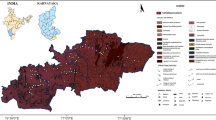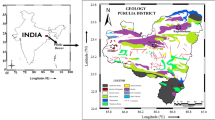Abstract
The concentrations of 226Ra and 222Rn were measured in ground water samples of Davanagere district, Karnataka state, India using emanometry technique. Activity of 226Ra and 222Rn in groundwater varied from 15.6 ± 3 to 68.9 ± 5 mBql−1 and 37 ± 4 to 245 ± 8 Bql−1 respectively. More than 53% of the water samples showed higher radon concentration compare to standard safe limit of 100 Bql−1 prescribed by WHO. Effective dose to the public due to 222Rn in water was found to vary from 0.15 to 1.00 mSvy−1 with an average of 0.49 mSvy−1.






Similar content being viewed by others
References
UNSCEAR (1982) Ionizing radiation: sources and biological effects. United Nations scientific committee on the effects of atomic radiation
Choubey VM, Bartarya SK, Saini NK, Ramola RC (2001) Impact of geohydrology and neotectonic activity on radon concentration in groundwater of intermontane Doon Valley, Outer Himalaya India. Environ Geol 40(3):257–266
Vinson DS, Campbell TR, Vengosh A (2008) Radon transfer from groundwater used in showers to indoor air. Appl Geochem 23(9):2676–2685
Mays CW, Rowland RE, Stehney AF (1985) Cancer risk from the lifetime intake of Ra and U isotopes. Health Phys 48(5):635–647
Sethi TK, El-Ghamry MN, Kloecker GH (2012) Radon and lung cancer. Clin Adv Hematol Oncol 10(3):157–164
Henshaw DL, Eatough JP, Richardson RB (1990) Radon as a causative factor in induction of myeloid leukaemia and other cancers. The Lancet 335(8696):1008–1012
Fornalski KW, Adams R, Allison W, Corrice LE, Cuttler JM, Davey C, Welsh JS (2015) The assumption of radon-induced cancer risk. Cancer Causes Control 26(10):1517–1518
UNSCEAR (2000) Annex B: Exposures from natural radiation sources, United Nations Scientific Committee on the Effects of Atomic Radiation, United States
Inacio M, Soares S, Almeida P (2017) Radon concentration assessment in water sources of public drinking of Covilhas county, Portugal. J Radiat Res Appl Sci 10(2):135–139
Prasad M, Kumar GA, Sahoo BK, Ramola RC (2018) A comprehensive study of levels and associated radiation dose in Himalayan ground water. Acta Geophys 66(55):1223–1231
Ezzulddin SK, Mansour HH (2020) Radon and radium activity concentration measurement in drinking water resources in Kurdistan Region-Iraq. J Radioanal Nucl Chem 324(3):963–976
Nagaraja K, Prasad BSN, Chandrashekara MS, Paramesh L, Madhava MS (2006) Inhalation dose due to radon and its progeny at Pune Indian. J Pure Appl Phys 44:353–359
Seminsky KZ, Seminsky AK (2019) Radon concentration in groundwater sources of the Baikal region (East Siberia, Russia). Appl Geochem 111:104446
Ground Water Information Booklet Davanagere District, Karnataka, Central Groundwater Board, Ministry of Water Resources, Government of India (2008)
Gaware JJ, Sahoo BK, Sapra YS, Mayya, (2011) Development of online thoron monitoring systems for occupation and general environments. BARC News Letter 318:45–51
Singh P, Singh P, Sahoo BK, Bajwa BS (2016) A study on uranium and radon levels in drinking water sources of a mineralized zone of Himachal Pradesh, India. J Radioanal Nucl Chem 309(2):541–549
Rani S, Kansal S, Singla AK, Mehra R (2021) Radiological risk assessment to the public due to the presence of radon in water of Barnala District, Punjab India. Environ Geochem Health 43(12):5011–5024
ASTM (1998) American society for testing and measurements, Standard test method for radon in drinking water, D5072–98
Rajesh BM, Chandrashekara MS, Nagaraja P, Paramesh L (2012) Studies on radon concentration in aqueous samples at Mysore city India. Radiat Protect Environ 35(1):9–13
Jobbagy V, Altzitzoglou T, Malo P, Tanner V, Hult M (2017) A brief overview on radon measurements in drinking water. J Environ Radioact 173:18–24
WHO (2011) World Health Organization, Guidelines for Drinking Water Quality-4th edition, Radiological aspects: 203–217
IAEA (2011) International Atomic Energy Agency, Radiation Protection and Safety Of Radiation Sources: International Basic Safety Standards, in IAEA Safety Standards, Interim ed. Austria
Census of India (2011) Karnataka, Davanagere district Census Handbook
National Informatics Centre, Davanagere district (2017), Government of India: statistical report
Raghavayya M, Iyengar MAR, Markose (1980) Estimation of 226Ra by emanometry. Bull Radiat Protect 11(2):33–35
ASTM (2005) American Society for testing and measurements, Standard test method for Radium-226 in water, D3454–05
Maharana M, Eappen KP, Sengupta, D (2010) Radon emanometric technique for 226Ra estimation. J Radioanal Nucl Chem 285(3):469–474
Sannappa J, Chandrashekara MS, Sathish LA, Paramesh L, Venkataramaiah P (2003) Study of background radiation dose in Mysore city, Karnataka State India. Radiat Measure 37(1):55–65
Porntepkasemsan B, Srisuksawad K (2008) Assessment of 226Ra age-dependent dose from water intake. Appl Radiat Isot 66(11):1654–1656
Institute of Medicine (2005) Dietary Reference Intakes for Water, Potassium, Sodium, Chloride, and Sulfate. The National Academies Press
Strain CD, Watson JE, Fong SW (1979) An evaluation of radium-226 and radon-222 concentrations in ground and surface water near a phosphate mining and manufacturing facility. Health Phys 37:779–783
USEPA (1991) United States Environmental Protection Agency (1991) Federal Register 40 Parts 141 and 142: National primary drinking water regulations for radionuclides: proposed rules, 56: 33050–33127
UNSCEAR (2019) Annex B: Lung cancer from exposure to radon, United Nations Scientific Committee on the Effects of Atomic Radiation. Sources and effects of ionizing radiation. New York: United Nations
WHO (2004) World health organization, guidelines for drinking water quality. Radiol Aspects, Geneva 1(3):1–203
Faweya EB, Agbetuyi OA, Talabi AO, Adewumi T, Faweya O (2021) Radiological Implication of 222Rn Concentrations in Waters from Quarries environs correlation with 226Ra concentrations and rocks Geochemistry. Arab J Geosci 14(11):1–15
Kozlowska B, Hetman A, Zipper W (1999) Determination of 222Rn in natural water samples from health resorts in the Sudety mountains by the liquid scintillation technique. Appl Radiat Isot 51(4):475–480
Wakita H, Igarashi G, Nakamura Y, Sano Y, Notsu K (1989) Coseismic radon changes in groundwater. Geophys Res Lett 16(5):417–420
Acknowledgements
Authors thank DST-SERB Govt of India for providing financial support to carry out this work. The authors express their profound gratitude to Prof. P. Venkataramaiah, Former Vice-chancellor, Kuvempu University and Professor (Retired), Department of Studies in Physics, University of Mysore, Mysore, for useful discussions and constant encouragement throughout the work.
Author information
Authors and Affiliations
Corresponding author
Additional information
Publisher's Note
Springer Nature remains neutral with regard to jurisdictional claims in published maps and institutional affiliations.
Rights and permissions
About this article
Cite this article
Hidayath, M., Chandrashekara, M.S., Rani, K.S.P. et al. Studies on the concentration of 226Ra and 222Rn in drinking water samples and effective dose to the population of Davanagere district, Karnataka state, India. J Radioanal Nucl Chem 331, 1923–1931 (2022). https://doi.org/10.1007/s10967-022-08240-1
Received:
Accepted:
Published:
Issue Date:
DOI: https://doi.org/10.1007/s10967-022-08240-1




